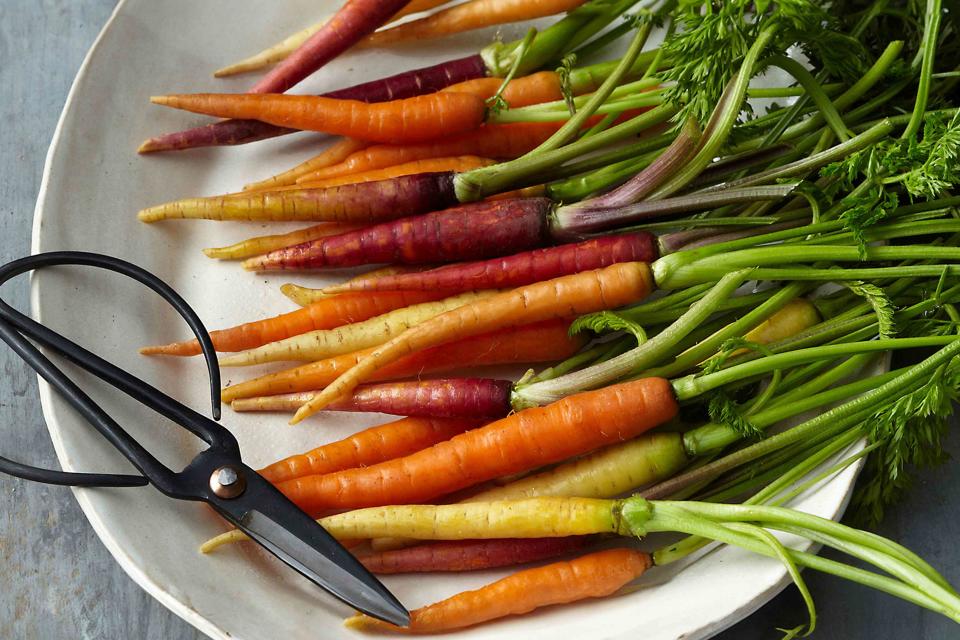How to Store Carrots So They Stay Crisp, According to Experts
Plus, what to do if your carrots have lost their crunch.

Diane Fields / MSLO
Whether you're curating a grazing board or creating a base for soup, there's a good chance you'll use carrots in an upcoming recipe. After all, carrots are important staple ingredients, thanks to their versatility, sweet flavor, and sturdy texture that holds up after cooking. Carrots can also last a long time—as long as you store them properly. Here, experts explain the best way to store carrots, whether they're peeled or unpeeled and whole or cut—plus, how to freeze them.
Meet Our Expert
Bryan Quoc Le, Ph.D., food scientist, food consultant, and author of 150 Food Science Questions Answered
Nathan Lyon, chef, cookbook author, and host of A Lyon in the Kitchen on Discovery Health
Related: The Right Way to Store Celery So It Stays Fresh and Crisp
How to Store Whole Carrots
Carrots should always be stored in the refrigerator, according to Bryan Quoc Le, Ph.D., food scientist, food consultant, and author of 150 Food Science Questions Answered. Otherwise, if they're kept at room temperature, they will lose sugar (and develop a bitter flavor) due to increased oxygen absorption.
Unpeeled
To properly store whole, unpeeled carrots, place them in a sealed plastic bag in the crisper drawer of your refrigerator, says Nathan Lyon, chef, cookbook author, and host of A Lyon in the Kitchen on Discovery Health. As with other produce, avoid washing the carrots before storing, as the excess moisture will accelerate spoilage. "Be sure to remove the greens prior to storing to preserve the [existing] moisture and sugar content in the carrot," adds Lyon.
Peeled
Whole peeled carrots should be stored in the same way as unpeeled ones. However, it's worth noting that the peel protects the moisture in the carrot, so peeling a carrot before storing will speed up the dehydration process, says Lyon.
Tips
Whether storing unpeeled or peeled carrots, be careful about what you store them with. "It's best to keep them away from other vegetables and fruits that produce ethylene, such as bananas, apples, stone fruits, grapes, broccoli, and asparagus,” explains Le. The ethylene from these items will make the carrots age faster, leading to lower sugar content and bitter flavors over time.
Shelf Life
When stored properly, whole carrots can last up to one month in the refrigerator, says Lyon.
How to Store Cut Carrots
To store cut carrots, loosely wrap them in a damp paper towel, then place them in a sealed plastic bag in your refrigerator's crisper drawer, says Lyon.
Some people suggest submerging cut carrots in water and storing them in an air-tight container in the refrigerator, but this can dilute the flavor, compromise the texture, and promote rotting, says Lyon. This technique also requires you to change the water every few days, which can be difficult to remember—so your best bet is to store cut carrots in a bag in your crisper drawer.
Shelf Life
Use cut carrots within two to three days, says Lyon.

How to Store Carrot Greens
Carrot tops are edible and nutritious. They can be added to salads, used as a garnish for pasta or drinks, or blended into sauces like pesto or chimichurri, just like herbs or other leafy greens.
Store carrot greens, unwashed, in a perforated plastic bag with a paper towel, which will help wick away moisture during storage, says Lyon. Then, place the plastic bag in the refrigerator.
Shelf Life
Carrot greens are delicate, so their shelf life is short, just one or two days.
Related: The Right Way to Store Celery So It Stays Fresh and Crisp
Can You Freeze Carrots?
Carrots are freezer-friendly vegetables. However, it's important to blanch them first, as the boiling water will deactivate enzymes in the carrots, which would otherwise yield a poor texture and flavor upon defrosting, says Le.
To freeze carrots, follow these steps:
Prepare an ice bath and line a baking sheet with parchment paper.
Bring a pot of water to a boil over high heat.
As the water comes to a boil, wash and peel the carrots. Trim off both ends.
Slice the carrots into ½-inch thick coins. You can also dice them.
Add the carrots to the pot. Blanch for 4 minutes.
Remove the carrots with a slotted spoon. Immediately put them in the ice bath.
Scoop out the carrots with a slotted spoon. Place them on a clean towel and pat dry.
Transfer the carrots to the baking sheet in a single, even layer.
Place in the freezer for 1 or 2 hours, or until frozen.
Transfer the carrots to a freezer-safe bag.
Shelf-Life
For the best quality, use frozen carrots within 10 to 12 months.
How to Fix Limp Carrots
During storage, carrots can lose water and become floppy and soft due to the lack of moisture in their cells, says Le. That's because carrot tissue needs enough water to keep its cell structures rigid. If you experience this issue, submerge the limp carrots in cold water for one hour, which may help bring back some of their crispness, says Lyon. "If not, they're still suitable for many [applications] such as roasting, baking, and soups," notes Lyon.
Signs Carrots Have Gone Bad
Although slightly limp carrots are safe to eat, you should toss ones that are mushy and soft; these signs indicate the carrots have spoiled. Other signs of bad carrots include a slimy texture, discoloration, and poor odor, according to Le.
Related: How to Store Potatoes the Right Way—and Prevent Them From Sprouting
Read the original article on Martha Stewart.

